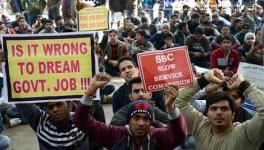How Pervasive Are Modi Govt Cutbacks on Job Schemes

At a time of widespread and intense concern about the worst unemployment situation in 45 years and all the distress and discontent that accompanies it, one would have expected the Union government to put job-creation at the top of its priority-list. One of the most obvious and direct ways to do this would be to expand its own schemes and programmes that can contribute new employment opportunities more directly. What has been the actual experience?
Start by looking at an important scheme under the Ministry of Micro, Small and Medium Enterprises (MSME), which has the Khadi and Village Industries Commission or KVIC as the nodal agency. For the Prime Minister’s Employment Generation Program (PMEGP, credit-based) there is an allocation of Rs 2,800 crore in the Budget Estimate of 2020-21. This is much less than the Budget Estimate of the previous year (Rs 3,274 crore) and the actual expenditure of 2017-18, which was Rs 4,113 crore.
So we have gone from Rs 4,113 crore to Rs 2,800 crore in a short span of two years—a reduction of 32%.
According to an answer to a recent question in Parliament, in 2018-19, PMEGP generated 5.9 lakh jobs. For 2019-20, the data is available for up to 31 December 2019. It shows that in the first nine months of the financial year, just 2.6 lakh jobs were generated under this scheme—this is a steep fall of around 56%. In other words, less than half the number of jobs were created by this scheme in just one financial year.
The budget of the Ministry of Skill Development and Entrepreneurship was Rs 2,989 core in the Budget Estimate of 2019-20. In the Revised Estimate, this was cut to Rs 2,531 crore. Within this ministry, the Budget Estimate for the most prominent scheme, called Prime Minister’s Kaushal Vikas Yojana, was Rs 2,677 crore. However, the Revised Estimate cut the allocation to Rs 2,247 crore. It is no surprise that the available figures for this year show a declining trend in the number of people who gained skills and jobs under this scheme too.
There ought to be particular concern about the decline of schemes which are dedicated to promote skills among women, whose participation in the workforce has been shrinking. According to a review of the latest budget by the Centre for Budget and Governance Accountability, the allocation for women-specific schemes such as the National Skill Training Institution and Jan Shakti Sansthan under the Ministry of Skill Development and Entrepreneurship has declined by Rs 107 crore in the budget as compared to the Budget Estimate of 2019-20.
Coming now to the Ministry of Labour and Employment. One would have expected an increase in the allocation for jobs and skill development including the Prime Minister’s Rojgar Protsahan Yojana. However the Budget Estimate for 2020-21 is only Rs 2,646 crore, a big—42%—drop compared to the Budget Estimate of Rs 4,584 crore in the previous case. In fact the budget estimate this year is even lower than the actual expenditure under this head in 2018-19 which amounted to Rs 3,563 crore. To sum up, the allocation so far this year is 25% lower than even what was spent a year ago.
The severe crisis in rural areas—as seen in the decline in per capita monthly expenditure, recorded with concern last November—is enough reason to expect the government to boost rural job creation. According to estimates prepared by People’s Action for Employment Guarantee, keeping in view the surge in rural employment needs, a budget of between Rs 85,000 crore and Rs 1,00,000 crore was needed this year. The actual allocation is only Rs 61,500 crore—a shortfall falling in the range of roughly 27-38%.
Note that the employment situation has to be estimated keeping in mind the MG-NREGS, which provides for separate allocations for drought relief works, which have reportedly stopped at most places.
Now consider the overall spending of the Department of Rural Development. This comprises 5.1% of the total Union government budgetary spending in 2017-18. In the Budget Estimate for 2020-21, this has come down to 3.9%. The allocation for National Rural Livelihood Mission has increased this year, but very marginally.
The Pradhan Mantri Gramin Sadak Yojana can also help to generate jobs directly as well as indirectly. In 2019-20, the Budget Estimate for this scheme was at Rs 19,000 crore. In the Revised Estimate this was cut heavily to Rs 14,070 crore, a 26% reduction.
There is also a marked decline in the generation of jobs under the Deendayal Antyodaya Yojana—National Urban Livelihood Mission scheme, under the Ministry of Housing and Urban affairs. According to published government data, in the first 10 months of 2019-20, until 27 January 2020, less than a fourth of people were skilled and placed under this scheme compared with the twelve months of the previous year (2018-19). The decline was from 1,80,000 to 44,000. The performance this year is poor even when compared to two previous years.
The actual expenditure on the much-discussed Pradhan Mantri MUDRA Yojana (through NCGTC) was Rs 1,500 crore in 2016-17. This year the allocation is Rs 510 crore, the same as in the previous year, 2019-20. It’s poor performance even in previous years is another matter altogether.
The allocations are only part of the story. The performance of several of these schemes is also marred by corruption and irregularities, which leads to much lesser than expected benefits. In the course of field visits to Uttar Pradesh I learned that in some places the influential gram pradhan gets the work of MG-NREGS done by machines—barred under the scheme—and then make false entries of his henchmen to show that workers were genuinely hired for these jobs. The money meant for wages are transferred to bank accounts of beneficiaries as provided by the influential figures in the village, but the money is then taken from them, after a small payment to them. Skill development programs in remote rural areas are also malfunctioning—and badly.
Clearly the government has performed poorly in the direct means available to it to generate employment. Drastic improvements are needed to fix the situation.
The writer is a freelance journalist who has been involved with several social movements. The views are personal.
Get the latest reports & analysis with people's perspective on Protests, movements & deep analytical videos, discussions of the current affairs in your Telegram app. Subscribe to NewsClick's Telegram channel & get Real-Time updates on stories, as they get published on our website.
























